
Wine Culture and Information since 2002 - Volume 22
 Wine Culture and Information since 2002 - Volume 22 |
|
Comparing Franciacorta Extra BrutFranciacorta represents one of the best expressions of Italian bubbles, produced in different styles, it is mainly made from Chardonnay and Pinot Noir grapes |
|
The revolution of Italian bubbles produced with the classic method began in the 1960s, in the historical area of Franciacorta, in province of Brescia, and today are considered among the best ones in the world. A remarkable job - with the only goal of quality without compromises - has in fact allowed the realization of this stupendous Italian wine making area, a job done with commitment and strictness both by producers and by Consorzio di Tutela del Franciacorta (Consortium for the Safeguarding of Franciacorta). And in these years the noble bubbles of Franciacorta took many satisfactions, even in competing - and sometimes also winning the challenge - with the noble and prestigious bubbles of Champagne, considered since centuries the indisputable and great homeland of sparkling wines refermented in bottle. Franciacorta's bubbles are mainly produced with Chardonnay and Pinot Noir grapes, to which it is sometimes added Pinot Blanc. Franciacorta is produced in different styles and sweetness levels - from “non dosato”, or dosaggio zero, nature or pas dosé, to demi sec, charming and pleasing, it is also a wine suited for the pairing with desserts. Franciacorta has been the first Italian wine produced with the method of refermentation in bottle - or classic method - to be ranked as Denominazione d'Origine Controllata e Garantita (DOCG, Denomination of Controlled and Guaranteed Origin), the highest level of quality in Italy. And it should also be remembered this wine cannot be called spumante: a specific law issued by the European Commission has in fact decided this wine must be exclusively called Franciacorta, with no other mention - including the DOCG mention - just like Champagne and Cava. With the term “Franciacorta” are therefore defined all the factors determining the identification, production method, territory and, of course, the wine itself.
|
|
Our comparative tasting will focus on a specific style of Franciacorta - Extra Brut - therefore a very dry wine with a pretty low quantity of sugar. According to the definition of sweetness styles used in the production of wines, it is defined as Extra Brut a wine having a quantity of residual sugar up to 6 grams per liter, therefore obtaining a pretty dry taste, although not completely dry as in the case of non dosato style. It should be noticed sweetness in these wines is obtained by the so called liqueur d'expedition added after disgorgement in order to fill in the bottle to the original level. In Franciacorta method, liqueur d'expedition is in fact made from a blend of wines, also of past vintages, and sugar. A particularity of Franciacorta method - as opposed to other classic method wines - are the long times in bottle on lees, a period which must be of at least 18 months, 24 months for Satèn style, 30 months for vintages and 60 months for reserve wines.
The goal of our comparative tasting is to understand the quality of Franciacorta in its “almost natural” style - Extra Brut can contain up to 6 grams of sugar per liter - that is the style which most resemble dosaggio zero, in which it is not used any liqueur d'expedition, therefore a completely dry wine. The first wine selected for the tasting is Ricci Curbastro's Franciacorta Extra Brut, produced with Chardonnay and Pinot Noir in equal parts and refermented in bottle for 42 months. The second wine is Bersi Serlini's Franciacorta Extra Brut Riserva, produced with Chardonnay and a small part of Pinot Blanc, refermented in bottle for 50 months. The last wine is Ferghettina's Franciacorta Extra Brut, produced with Chardonnay and a small part of Pinot Noir, refermented in bottle for 6 years. The three wines will be served at a temperature of 12°C (53°F), in order to favor the full development of aromas - therefore scarifying the persistence of perlage - and will be poured in three ISO tasting glasses.
|
||||||||
|
One of the main characteristics in which it is paid attention during the evaluation of sparkling wines, it is the quality of the so called perlage, that is the aspect and the development of bubbles, which from the base of the glass move upwards to the surface. One of the characteristics determining quality of bubbles is the size, which in classic method wines must always be small, or better, very small, even with a diameter lesser than half a millimeter. Persistence, that is the time during which bubbles can be noticed in the glass, must be long, even though this phenomenon is determined not only by the quality of the production method, but also by temperature: the lower, the longer the persistence. The color in Franciacorta is determined by many aspects: varieties of grapes, time of contact with lees and, last but not the least, base wine fermented or aged in cask. In general terms, the color in Franciacorta can range from straw yellow to intense golden yellow. Let's start the phase of appearance analysis from Ricci Curbastro's Franciacorta Extra Brut. By holding the glass at eyes level, in vertical position and without swirling, it will be observed the development of bubbles. The perlage of this wine is made from very small bubbles and of good persistence, whereas color - observed by tilting the glass over a white surface - is characterized by brilliant golden yellow color and nuances of the same color. Also the perlage of the second wine - Bersi Serlini's Franciacorta Extra Brut Riserva - shows bubbles of small size and of good persistence, with a paler color than the previous wine, in this case intense straw yellow and nuances of the same color. The analysis of Ferghettina's Franciacorta Extra Brut reveals a perlage with very small and persistent bubbles, whereas the color shows an evident brilliant golden yellow hue with straw yellow nuances.
|
|
Thanks to the long times of refermentation and aging in bottle, Franciacorta wines - in particular reserve and vintage styles - give the nose of taster an interesting experience rich in complex aromas. The long stay in bottle in contact with lees, in fact favors a pretty rich aromatic development, a quality which is mainly favored by the autolysis of yeast, that is by their degradation, therefore enriching the wine with their aromas. The fermentation and the aging of base wine in wood containers, contributes to the enrichment of the aromatic complexity of Franciacorta, in which can also be perceived aromas of vanilla, although never exceeding to the strong and characteristic aromas of toasted wood. The general olfactory profile of Franciacorta strongly depends on the grapes with which it was produced, and it can also be found aromas of red berried fruits, given by Pinot Noir grape. The first wine we will examine in the olfactory analysis phase is Ricci Curbastro's Franciacorta Extra Brut. By holding the glass in vertical position and without swirling, we will proceed with the first smell, in order to appreciate the so called “opening aromas”, that is the aromatic qualities which mainly identify a wine. From the glass will be perceived intense, clean and pleasing aromas of pineapple, apple and pear, as well as a pleasing flowery touch of broom. After having swirled the glass - in this way it will be favored the development of the other aromatic substances and which need a higher quantity of oxygen to volatilize - we will proceed with the second smell. From the glass will be appreciated the typical aromas given by the fermentation and aging in bottle, in which can be recognized yeast and toasted wood, to which are added plum, hazelnut, honey, grapefruit and butter. Let's now pass to the second wine of our comparative tasting: Bersi Serlini's Franciacorta Extra Brut Riserva. The opening of this Franciacorta - evaluated by holding the glass in vertical position and without swirling - gives the nose intense, clean and pleasing aromas of banana, apple and plum. After having swirled the glass, we will proceed with the second smell, therefore completing the profile of the wine with aromas of yeast, bread crust, butter, pineapple, hawthorn, pear, grapefruit, hazelnut and croissant. The opening of the third wine - Ferghettina's Franciacorta Extra Brut - gives the nose intense, clean and pleasing aromas of banana, peach and hazelnut, in which it is mainly perceived, as opposed to the previous wines, the influence of Chardonnay. After having swirled the glass, we will proceed with the second smell which will complete the profile of the wine with yeast, bread crust, acacia, apple, pear, hawthorn, plum, raspberry, tangerine, praline and pink grapefruit. It should also be noticed the complexity of the three wines according to the composition of grapes and to the times of aging.
|
||||
|
In the gustatory analysis, one of the main qualities of Franciacorta Extra Brut is its basically dry taste, although not completely dry, a quality which also exalts crispness. The Extra Brut style can in fact contain a quantity of sugar up to 6 grams per liter, added after disgorgement with the liqueur d'expedition. The long aging in bottle will also give the wine an evident roundness and softness, qualities contributing both to the elegance and balance of the wine. Another important characteristic of classic method wines is effervescence, given by carbon dioxide produced during the refermentation in bottle. It should be noticed carbon dioxide has a basically acid taste and which therefore increases crispness in a wine. Moreover, carbon dioxide attenuates the perception of sweetness, therefore a wine will seem drier despite the presence of sugar. The first wine of which will evaluate taste is Ricci Curbastro's Franciacorta Extra Brut. The attack of this Franciacorta - that is the initial sensation which can be perceived in the mouth at the first sip - is characterized by a good effervescence and by a pleasing perception of crispness given by acidity, as well as pleasing roundness and softness given both by aging and by alcohol. The attack of the second wine - Bersi Serlini's Franciacorta Extra Brut Riserva - is characterized by an evident effervescence and crispness, qualities which leaves “the scene” to the pleasing sensation of roundness, which is also increased by alcohol. Also the attack of the third wine - Ferghettina's Franciacorta Extra Brut - is characterized by an evident effervescence and crispness, as well as a pleasing sensation of roundness, in this wine being more evident than the previous ones. It should also be noticed - in all the three wines - the evident dry taste, in which it is not perceived any sweetness and the small quantity of sugar contributes, in this case, to increase roundness and body of wine.
|
|
Franciacorta Extra Brut is the style to be more similar to “dosaggio zero”, that is the most natural of all Franciacortas in which corrections are not possible, a style particularly appreciated by wine lovers. The finish of Ricci Curbastro's Franciacorta Extra Brut is persistent leaving in the mouth intense and clean flavors of banana, hazelnut and grapefruit. The finish of the second wine - Bersi Serlini's Franciacorta Extra Brut Riserva - is persistent with flavors of banana, plum and apple. Also the finish of Ferghettina's Franciacorta Extra Brut is persistent, leaving in the mouth long flavors of banana, peach, tangerine and hazelnut. It should be noticed - in all the three wines - the sensation of crispness and roundness which can also be perceived after having swallowed the wine, as well as the excellent balance and the evident elegance, in which a lower sweetness - or the almost total absence of sweetness - allow a better appreciation of the natural qualities of Franciacorta.
|
Wines of the Month |
|
|
|
Score legend Prices are to be considered as indicative. Prices may vary according to the country or the shop where wines are bought |

|
|
Colli di Faenza Sangiovese Re Nero 2007 |
|
| TreRè (Emilia Romagna, Italy) | |
| Grapes: Sangiovese | |
| Price: € 18.00 | Score: |
| Colli di Faenza Sangiovese Re Nero shows an intense ruby red color and nuances of purple red, little transparency. The nose denotes intense, clean, pleasing and refined aromas which start with hints of black cherry, plum and violet followed by aromas of strawberry, blackberry, blueberry and hints of vanilla. The mouth has good correspondence to the nose, a tannic attack and however balanced by alcohol, good body, intense flavors, pleasing crispness. The finish is persistent with flavors of black cherry and plum. Colli di Faenza Sangiovese Re Nero ages for 4 months in barrique. | |
| Food Match: Stuffed pasta, Broiled meat and barbecue, Stewed meat with mushrooms | |
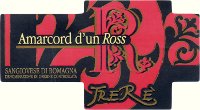
|
|
Sangiovese di Romagna Riserva Amarcord d'un Ross 2005 |
|
| TreRè (Emilia Romagna, Italy) | |
| Grapes: Sangiovese (85%), Cabernet Sauvignon (15%) | |
| Price: € 22.00 | Score: |
| Sangiovese di Romagna Riserva Amarcord d'un Ross shows an intense ruby red color and nuances of ruby red, little transparency. The nose denotes intense, clean, pleasing and refined aromas which start with hints of plum, black cherry and violet followed by aromas of blackberry, blueberry, vanilla, tobacco, chocolate, pink pepper and menthol. The mouth has good correspondence to the nose, a tannic attack and however balanced by alcohol, good body, intense flavors. The finish is persistent with flavors of plum, black cherry and blueberry. Sangiovese di Romagna Riserva Amarcord d'un Ross ages in barrique. | |
| Food Match: Roasted meat, Stewed and braised meat with mushrooms, Hard cheese | |
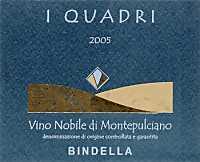
|
|
Vino Nobile di Montepulciano I Quadri 2005 |
|
| Bindella (Tuscany, Italy) | |
| Grapes: Sangiovese | |
| Price: € 17.50 | Score: |
| Vino Nobile di Montepulciano I Quadri shows a brilliant ruby red color and nuances of ruby red, moderate transparency. The nose denotes intense, clean, pleasing and refined aromas which start with hints of cherry, plum and violet followed by aromas of raspberry, vanilla, chocolate, mace, tobacco, cinnamon and leather. The mouth has good correspondence to the nose, a tannic attack and pleasing crispness, however balanced by alcohol, full body, intense flavors. The finish is persistent with flavors of cherry, plum and raspberry. Vino Nobile di Montepulciano I Quadri ages for 18 months in cask followed by 12 months of aging in bottle. | |
| Food Match: Game, Roasted meat, Braised and stewed meat, Hard cheese | |
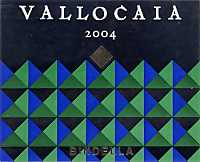
|
|
Vallocaia 2004 |
|
| Bindella (Tuscany, Italy) | |
| Grapes: Sangiovese (34%), Cabernet Sauvignon (33%), Syrah (33%) | |
| Price: € 26.00 | Score: |
| Vallocaia shows a brilliant ruby red color and nuances of ruby red, moderate transparency. The nose reveals intense, clean, pleasing, refined and elegant aromas that start with hints of black cherry, plum and black currant followed by aromas of violet, vanilla, blueberry, chocolate, tobacco, black pepper, mace and menthol. The mouth has good correspondence to the nose, a tannic attack and however balanced by alcohol, full body, intense flavors. The finish is persistent with flavors of black cherry, plum and black currant. Vallocaia ages for 18 months in cask followed by 12 months of aging in bottle. | |
| Food Match: Game, Roasted meat, Stewed and braised meat, Hard cheese | |
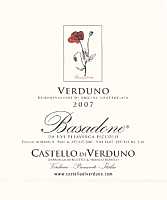
|
|
Verduno Pelaverga Basadone 2007 |
|
| Castello di Verduno (Piedmont, Italy) | |
| Grapes: Pelaverga | |
| Price: € 10.00 | Score: |
| Verduno Pelaverga Basadone shows a brilliant ruby red color and nuances of ruby red, moderate transparency. The nose denotes intense, clean and pleasing aromas that start with hints of cherry, raspberry and strawberry followed by aromas of plum, violet, cyclamen and black pepper. The mouth has good correspondence to the nose, a pleasing crisp attack and slight astringency, however balanced by alcohol, good body, intense flavors. The finish is persistent with flavors of cherry, strawberry and raspberry. Verduno Pelaverga Basadone ages for 3 months in cask, 7 months in steel tanks and for 2 months in bottle. | |
| Food Match: Pasta with mushrooms, Sauteed meat with mushrooms | |
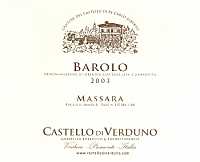
|
|
Barolo Massara 2003 |
|
| Castello di Verduno (Piedmont, Italy) | |
| Grapes: Nebbiolo | |
| Price: € 26.00 | Score: |
| Barolo Massara shows a brilliant ruby red color and nuances of garnet red, moderate transparency. The nose denotes intense, clean, pleasing and refined aromas which start with hints of cherry, plum and raspberry followed by aromas of violet, rose, vanilla, tobacco, cinnamon and cocoa. The mouth has good correspondence to the nose, a tannic attack and pleasing crispness, however balanced by alcohol, full body, intense flavors. The finish is persistent with flavors of cherry, plum and raspberry. Barolo Massara ages for 41 months in cask, 4 months in steel tanks and for at least 16 months in bottle. | |
| Food Match: Game, Roasted meat, Stewed and braised meat, Hard cheese | |
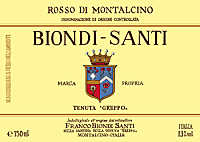
|
|
Rosso di Montalcino Etichetta Bianca 2006 |
|
| Biondi Santi (Tuscany, Italy) | |
| Grapes: Sangiovese | |
| Price: € 28.00 | Score: |
| Rosso di Montalcino Etichetta Bianca shows a brilliant ruby red color and nuances of ruby red, moderate transparency. The nose denotes intense, clean, pleasing and refined aromas which start with hints of black cherry, plum and violet followed by aromas of raspberry, rose, vanilla, tobacco and carob. The mouth has good correspondence to the nose, a tannic attack and however balanced by alcohol, good body, intense flavors, pleasing crispness. The finish is persistent with flavors of black cherry, plum and raspberry. Rosso di Montalcino Etichetta Bianca ages for 12 months in cask followed by at least 4 months of aging in bottle. | |
| Food Match: Broiled meat and barbecue, Roasted meat, Stewed and braised meat with mushrooms | |
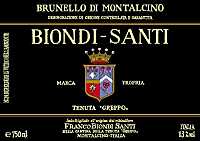
|
|
Brunello di Montalcino 2003 |
|
| Biondi Santi (Tuscany, Italy) | |
| Grapes: Sangiovese | |
| Price: € 65.00 | Score: |
| This Brunello di Montalcino shows a brilliant ruby red color and nuances of garnet red, moderate transparency. The nose reveals intense, clean, pleasing, refined and elegant aromas which start with hints of black cherry, plum and violet followed by aromas of raspberry, blueberry, vanilla, tobacco, cinnamon, chocolate, leather, tar, licorice and menthol. The mouth has excellent correspondence to the nose, a tannic attack and however balanced by alcohol, full body, intense flavors, pleasing crispness. The finish is very persistent with long flavors of black cherry, plum and blueberry. This Brunello di Montalcino ages for 36 months in cask. | |
| Food Match: Game, Roasted meat, Braised and stewed meat, Hard cheese | |
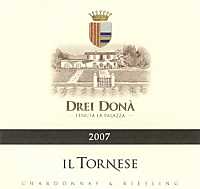
|
|
Il Tornese 2007 |
|
| Drei Donà (Emilia Romagna, Italy) | |
| Grapes: Chardonnay (85%), Riesling (15%) | |
| Price: € 11.00 | Score: |
| Il Tornese shows a pale straw yellow color and nuances of greenish yellow, very transparent. The nose denotes intense, clean, pleasing and refined aromas which start with hints of apple, grapefruit and banana followed by aromas of acacia, toasted wood, pineapple, pear, vanilla, plum and face powder. The mouth has good correspondence to the nose, a crisp attack and however balanced by alcohol, good body, intense flavors, agreeable. The finish is persistent with flavors of pineapple, plum and grapefruit. Il Tornese ages in part in cask and in part in steel tanks. | |
| Food Match: Fried fish, Pasta and risotto with fish, Stewed fish | |
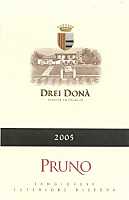
|
|
Sangiovese di Romagna Superiore Riserva Il Pruno 2005 |
|
| Drei Donà (Emilia Romagna, Italy) | |
| Grapes: Sangiovese | |
| Price: € 21.00 | Score: |
| Sangiovese di Romagna Superiore Riserva Il Pruno shows a brilliant ruby red color and nuances of ruby red, moderate transparency. The nose reveals intense, clean, pleasing, refined and elegant aromas which start with hints of black cherry, plum and violet followed by aromas of blueberry, blackberry, vanilla, tobacco, chocolate, black pepper, mace and menthol. The mouth has good correspondence to the nose, a tannic attack and however balanced by alcohol, good body, intense flavors, agreeable. The finish is persistent with flavors of plum, black cherry and blueberry. Sangiovese di Romagna Superiore Riserva Il Pruno ages in cask for 18 months followed by 10 months of aging in bottle. | |
| Food Match: Roasted meat, Stewed and braised meat, Hard cheese | |
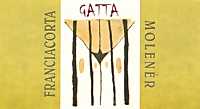
|
|
Franciacorta Extra Brut Molenèr 2000 |
|
| Gatta (Lombardy, Italy) | |
| Grapes: Chardonnay (70%), Pinot Noir (30%) | |
| Price: € 28.80 | Score: |
| Franciacorta Extra Brut Molenèr shows a brilliant straw yellow color and nuances of straw yellow, very transparent, good effervescence, fine and persistent perlage. The nose reveals intense, clean, pleasing and refined aromas which start with hints of banana, apple and raspberry followed by aromas of yeast, bread crust, hawthorn, hazelnut, praline, pear and butter. The mouth has good correspondence to the nose, an effervescent and crisp attack and however balanced by alcohol, good body, intense flavors, pleasing roundness. The finish is persistent with flavors of banana, apple and hazelnut. Part of the base wine ferments and ages in barrique. Franciacorta Extra Brut Molenèr referments in bottle for at least 60 months. | |
| Food Match: Roasted fish, Roasted white meat, Mushroom soups, Stuffed pasta | |
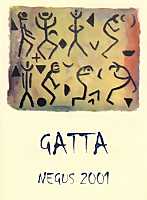
|
|
Cellatica Superiore Negus 2001 |
|
| Gatta (Lombardy, Italy) | |
| Grapes: Barbera, Marzemino, Incrocio Terzi, Schiava Gentile | |
| Price: € 25.30 | Score: |
| Cellatica Superiore Negus shows an intense ruby red color and nuances of garnet red, little transparency. The nose denotes intense, clean, pleasing and refined aromas which start with hints of cherry, plum and violet followed by aromas of blueberry, blackberry, vanilla, tobacco, chocolate, pink pepper and eucalyptus. The mouth has good correspondence to the nose, a tannic attack and however balanced by alcohol, good body, intense flavors, pleasing crispness. The finish is persistent with flavors of cherry, blueberry and plum. Cellatica Superiore Negus ages for about 24 months in barrique followed by 2 years of aging in bottle. | |
| Food Match: Roasted meat, Braised and stewed meat, Hard cheese | |
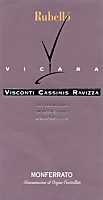
|
|
Monferrato Rosso Rubello 2003 |
|
| Vicara (Piedmont, Italy) | |
| Grapes: Barbera, Cabernet Sauvignon, Nebbiolo | |
| Price: € 12.80 | Score: |
| Monferrato Rosso Rubello shows an intense ruby red color and nuances of garnet red, little transparency. The nose denotes intense, clean, pleasing and refined aromas that start with hints of black cherry, plum and violet followed by aromas of blueberry, black currant, vanilla, cocoa, tobacco, licorice and menthol. The mouth has good correspondence to the nose, a tannic attack and however balanced by alcohol, good body, intense flavors, pleasing crispness. The finish is persistent with flavors of black cherry, plum and black currant. Monferrato Rosso Rubello ages for 20 months in cask followed by 12 months of aging in bottle. | |
| Food Match: Roasted meat, Broiled meat and barbecue, Stewed and braised meat with mushrooms, Hard cheese | |
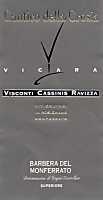
|
|
Barbera del Monferrato Superiore Cantico della Crosia 2003 |
|
| Vicara (Piedmont, Italy) | |
| Grapes: Barbera | |
| Price: € 14.00 | Score: |
| Barbera del Monferrato Superiore Cantico della Crosia shows a deep ruby red color and nuances of ruby red, little transparency. The nose reveals intense, clean, pleasing, refined and elegant aromas which start with hints of cherry, plum and violet followed by aromas of blueberry, blackberry, vanilla, cinnamon, cocoa, tobacco, mace and menthol. The mouth has good correspondence to the nose, a tannic attack and however balanced by alcohol, full body, intense flavors, agreeable. The finish is persistent with flavors of cherry, plum and blueberry. Barbera del Monferrato Superiore Cantico della Crosia ages in barrique. | |
| Food Match: Game, Braised and stewed meat, Roasted meat, Hard cheese | |
|
||||||||
|
DiWineTaste Polls
|
| |||||||
Privacy Policy | |||||||


| Copyright © 2002-2024 Antonello Biancalana, DiWineTaste - All rights reserved |
| All rights reserved under international copyright conventions. No part of this publication and of this WEB site may be
reproduced or utilized in any form or by any means, electronic or mechanical, without permission in writing from DiWineTaste. |